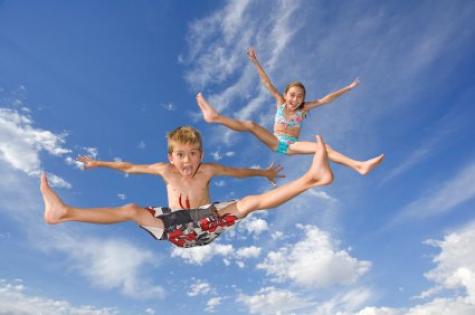A study of more than 650 people conducted by Kidsafe Western Australia on behalf of the ACCC showed 40% of parents' children had being injured on a trampoline or they were aware of someone else’s child who had injured themselves.
In Australia, an average of 2,000 trampoline-related injuries are reported each year, including bone fractures, superficial contusions and head injuries. Children aged between four and six are more likely to be injured.
“The survey identified a range of unsafe practices that may be putting children at increased risk of injury,” ACCC Deputy Chair Delia Rickard said.
“For example, multiple children shared use of one trampoline over 80 per cent of the time. We have reports of up to five or more children being on a trampoline at once.”
“Also of concern is that less than a quarter of parents and carers said they always supervise their children on trampolines,” Ms Rickard said.
“While the research indicates that some parents and carers are taking precautions such as regularly checking for wear and tear, we need to ensure that all consumers are following safety information. Trampolines can put children at risk of serious injuries when used inappropriately.”
The ACCC will be using the survey results to develop a national trampoline safety campaign in partnership with state and territory consumer protection agencies while also working with Standards Australia to improve the Australian Standard for trampolines.
“Parents and carers should be aware of unsafe practices when using and situating a trampoline and take adequate precautions to reduce the risk of injury,” Ms Rickard said.
Follow these simple tips to keep kids safe on trampolines:
· Use safety padding on the frame to avoid injuries if a child accidentally hits the frame.
· Buy safety pads to completely cover the steel frame and springs if your trampoline does not have them.
· Ensure that the area around the trampoline, ideally 2.5 metres wide on all sides, is free from hazards like walls, play equipment or garden furniture. A minimum overhead clearance of eight metres from ground level is recommended to avoid objects like clothes lines, trees and wires.
·If possible, cover at least a 2.5 metre wide area of ground all around the trampoline with a thick layer of soft, impact-absorbing material—for example pine bark and woodchips. Rake this regularly to reduce compacting.
· Ensure only one child at a time uses the trampoline.
· Supervise children at all times, regardless of age and take extra care with younger children as they are more prone to serious injury on trampolines.
· Keep toddlers away from the trampoline when it is in use and especially ensure they do not go underneath it. Infants can suffer serious injuries from falls, pinching and crushing if they use trampolines or are near a trampoline others are using.
· Regularly check that the trampoline is in good condition to ensure that the mat does not have holes, springs are intact and securely attached at both ends, frame is not bent and leg braces are securely locked.
· Also, if your trampoline has a safety net, ensure that you regularly check its condition as it is prone to deterioration due to exposure to sunlight.
· Ensure your children learn basic bounces first before trying more complex manoeuvres – overconfidence can lead to injury.

















__small.png)










